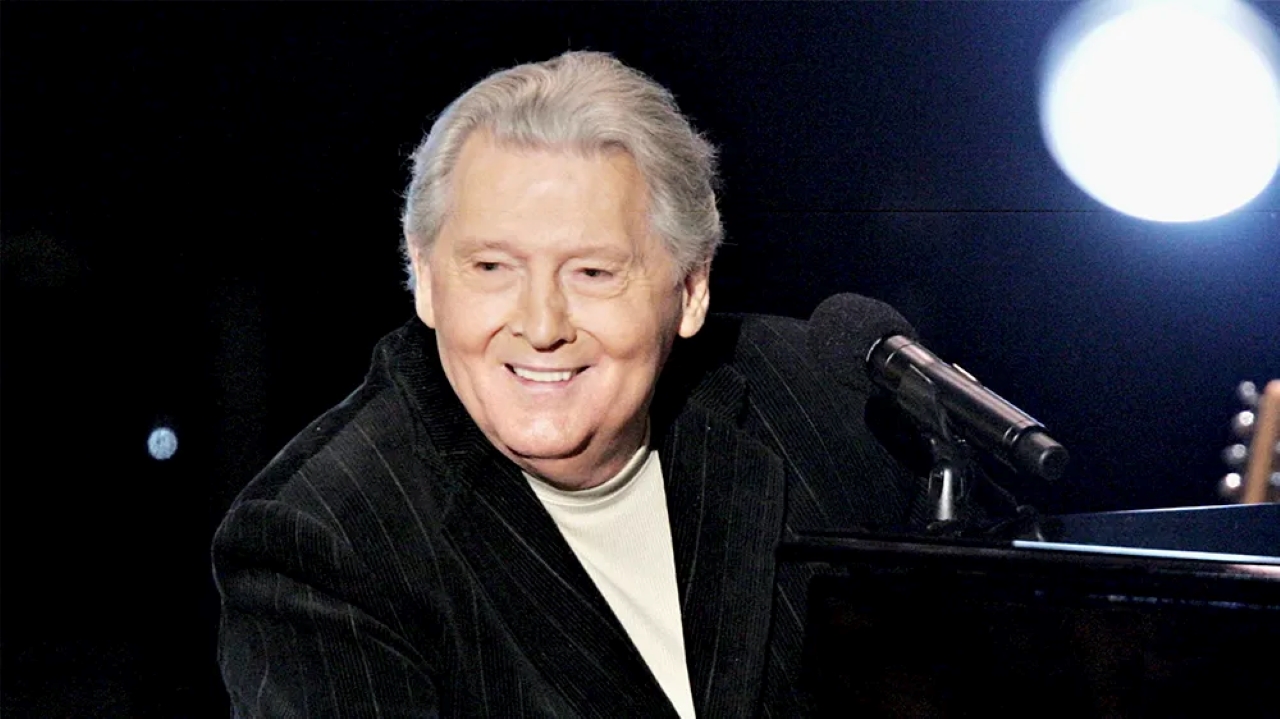⭐ A Birth That Shook the Future of Music
On September 29, 1935, in Ferriday, Louisiana, a boy was born who would one day set pianos on fire—sometimes literally—and leave an indelible mark on rock ’n’ roll. Jerry Lee Lewis, nicknamed “The Killer,” grew up in a poor farming family surrounded by gospel hymns, honky-tonk tunes, and the raw blues pouring out of Southern juke joints.
Even as a child, Jerry Lee seemed possessed by music. His parents mortgaged their farm to buy him a piano, believing their son had a gift worth nurturing. That gamble would pay off, though no one in Ferriday could have imagined the chaos, brilliance, and scandal that lay ahead.

⭐ Early Struggles and Sun Records
In the mid-1950s, Jerry Lee made his way to Memphis, Tennessee—the heart of the rockabilly explosion. He walked into Sun Records, the same studio that had launched Elvis Presley, Johnny Cash, and Carl Perkins. Sam Phillips, the label’s visionary owner, quickly realized Jerry Lee was something different.
His piano playing was ferocious, blending boogie-woogie, country, and gospel with a speed and aggression no one had heard before. His voice was raw, playful, and full of swagger. Unlike the guitar-driven rock of Elvis or Chuck Berry, Jerry Lee put the piano front and center, pounding keys with fists, elbows, and even his feet.
By 1957, he had recorded a song that would define him: “Great Balls of Fire.”
⭐ The Rise of “The Killer”
“Great Balls of Fire” became one of the biggest hits of the 1950s, selling millions and sending Jerry Lee into superstardom. With his wild stage antics—leaping on pianos, kicking over benches, and setting instruments ablaze—he became both a sensation and a scandal.
Where Elvis had the smooth sex appeal and Chuck Berry had streetwise cool, Jerry Lee embodied pure chaos. His performances were dangerous, unpredictable, and thrilling. To see Jerry Lee Lewis live was to witness something closer to a spiritual possession than a concert.
Audiences either loved him or feared him, but no one forgot him.
⭐ Scandal and the Fall from Grace
Just as his career was peaking, Jerry Lee’s personal life brought him crashing down. In 1958, during a tour of England, the press uncovered that the 22-year-old star had secretly married his 13-year-old cousin, Myra Gale Brown. The scandal was explosive. Concerts were canceled, radio stations blacklisted him, and his reputation was shattered.
For years afterward, Jerry Lee’s career never fully recovered. While contemporaries like Elvis went on to Hollywood and Johnny Cash found redemption in country music, Jerry Lee was stuck in exile, playing small clubs and fighting to keep his name alive.
But The Killer was nothing if not resilient.
⭐ A Country Reinvention
By the late 1960s, Jerry Lee reinvented himself—not as a rock ’n’ roll star, but as a honky-tonk country singer. Songs like “What’s Made Milwaukee Famous (Has Made a Loser Out of Me)” and “She Even Woke Me Up to Say Goodbye” brought him back to the charts.
He scored more than a dozen Top 10 country hits, proving that his talent was too great to be confined to one genre. His voice, now rougher and wiser, carried heartbreak as convincingly as it once carried reckless joy.
This second act showed that Jerry Lee Lewis wasn’t just a wild man—he was a true musician, capable of channeling his demons into songs that spoke to millions.
⭐ The Legacy of a Rebel
Jerry Lee’s career spanned over six decades, filled with triumphs and tragedies. He outlived many of his peers, including Elvis, Johnny Cash, and Carl Perkins—the so-called “Million Dollar Quartet” who once jammed together at Sun Studios.
He was inducted into the Rock and Roll Hall of Fame in 1986 and continued performing well into his 80s, still pounding the piano with the same ferocity that had made him famous. In 2022, just months before his death, he was inducted into the Country Music Hall of Fame—a recognition of both halves of his career.
Jerry Lee Lewis was never an easy figure to admire. His scandals, temper, and self-destructive behavior often overshadowed his artistry. But when he sat at a piano, all of that fell away. Few artists in history have embodied the raw, untamed spirit of rock ’n’ roll as completely as The Killer.
⭐ Conclusion – Born to Set the World on Fire
September 29, 1935, wasn’t just the birth of Jerry Lee Lewis—it was the birth of a force of nature. His life was messy, controversial, and often tragic. But his music—fierce, joyful, and unrepentant—remains eternal.
Every time someone pounds a piano in a barroom or belts a song with reckless abandon, they are echoing Jerry Lee’s spirit. He was the wild child who reminded the world that rock ’n’ roll wasn’t meant to be safe—it was meant to burn.